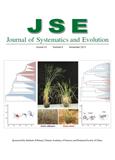Jeanett ESCOBEDO-SARTI, Ivón RAMÍREZ, Carlos LEOPARDI, Germán CARNEVALI, Susana MAGALLÓN, Rodrigo DUNO, Demetria MONDRAGÓN
There are 26 phylogenetic studies for Bromeliaceae based on different sources of evidence. Despite this broad phylogenetic coverage of Bromeliaceae, however, the available phylogenetic data display a scattered sampling, with little overlap among different types of evidence. The aim of this study is to integrate the available phylogenetic information of the Bromeliaceae in one hypothesis using a supertree. To test which of them integrates best the information for Bromeliaceae, nine supertree methods were employed: Avcon, MSS, MinFlip, MMC, MRP, PhySIC_IST, Robinson–Foulds Supertree, Sfit, and SuperFine. Supertrees were compared with a reference tree, generated from the maximum likelihood (ML) analysis of a supermatrix integrated by 120 taxa of Bromeliaceae and seven cpDNA regions. In order to select which method best reconstructs the most robust phylogeny, two different sets of source trees were used: (i) those generated from the analysis of each individual DNA regions; and (ii) four selected phylogenies (from the 26 published works). We used the consensus fork index, normalized partition metric, patristic distance coefficient, and the Shimodaira–Hasegawa test to compare supertrees with the reference tree. The best performing methods were used to construct a supertree using all phylogenies of Bromeliaceae. The SuperFine method generated the best supertree. The lack of overlapping among phylogenies was the major limiting factor for the integration of the phylogenetic information of Bromeliaceae. Nonetheless, supertree methods helped in the identification of poorly sampled groups, as well as to explore levels of agreement among published phylogenetic studies for Bromeliaceae.

